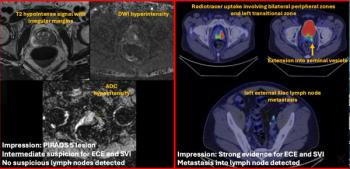
Cell-tracking study opens career door as well as window on vessel disease
When Jiangyang Zhang, Ph.D., picked up his Research Trainee Prize from RSNA 2005, the former biomedical engineering student was on a temporary research contract at the Johns Hopkins University radiology department. This September, his status will be upgraded to that of assistant professor. While the promotion was not due to the RSNA award alone, Zhang believes that recognition may have helped his quest for tenure.
His research helped Jiangyang Zhang, Ph.D. earn a professorship at Johns Hopkins University.
When Jiangyang Zhang, Ph.D., picked up his Research Trainee Prize from RSNA 2005, the former biomedical engineering student was on a temporary research contract at the Johns Hopkins University radiology department. This September, his status will be upgraded to that of assistant professor. While the promotion was not due to the RSNA award alone, Zhang believes that recognition may have helped his quest for tenure.
"It is a great honor for me to have this award," he said. "It tells me that I am moving in the right direction, which is very encouraging. And now when people look at my CV, they can see this award, so that is definitely a big help in my career."
The award was also of more immediate practical benefit. Zhang used a portion of the $1000 prize to fund his travel to Chicago and accommodations during the meeting. The remainder went toward paying off college loans.
Zhang was singled out by the RSNA for his work on MR-guided cell tracking. Together with colleagues from the Johns Hopkins MRI research division, he has succeeded in developing an MRI-based method of monitoring the movement of bone marrow cells to simulated arterial stenoses. Because bone marrow cells are known to migrate toward arterial plaques, they are attracting interest as a possible way to deliver drug- or gene-based treatments for atherosclerosis. Zhang's study provides preliminary evidence that the novel transport mechanism, if realized, could be monitored.
The study comprised two parts. Researchers first needed to confirm that bone marrow cells would migrate to injured arteries being used to mimic stenoses. They achieved this by transplanting bone marrow cells expressing green fluorescent protein into four nude mice, each with an injured left femoral-iliac artery. Subsequent fluorescence microscopy revealed an increase in green signal intensity when the injured left arteries were compared with uninjured right femoral-iliac arteries. This was true for all four mice.
The second phase of the study used MRI to monitor the cells' progress. Bone marrow cells were tagged with the superparamagnetic iron oxide contrast Feridex prior to implantation in eight nude mice, each with an injured left femoral artery. In vivo MRI on a 4.7T scanner and ex vivo MRI at either 9.4T or 11.7T demonstrated hypointensity from the injured artery in six cases. No such signal loss was observed for any of the uninjured (right) arteries.
Ex vivo high-resolution MRI of bilateral groin areas of mouse (inside rectangular boxes). Left femoral artery was mechanically narrowed by a cuff following transplantation of Feridex-labeled bone marrow cells. A: MRI shows that Feridex-labeled bone marrow cells (signal voids indicated by arrows) have migrated to injured left femoral artery. Uninjured right side has no signal loss. B, C: MRI findings are confirmed by histochemical staining for iron with Prussian blue. Feridex-positive cells (blue-colored spots) are detected near cuff of injured left femoral artery (LFA). No Feridex-positive cells are seen around the uninjured right femoral artery (RFA in B). (Provided by Jiangyang Zhang, Johns Hopkins University)
"This was the first time that we had used microMR to look at bone marrow cells, so it was quite exciting just to see these cells migrate to the site of injury," Zhang said. "We were also pleased to be able to see the cells near the arteries. Visualizing such vessels, which have very thin walls, is a significant technical challenge."
This new approach to bone marrow cell tracking will bring many benefits to radiology research, according to Zhang.
"People previously used pathology methods to look at the migration of bone marrow cells. But histology is a localized technique - you don't get a global picture of where the cells are moving - and it is very time-consuming. Also, you can't do longitudinal studies on the animals," he said.
The next significant challenge will be to quantify the number of cells migrating to injury sites. This will help indicate how effective treatments might be and the extent of vessel repair that could be expected. Zhang would also like to assess the technique's sensitivity.
The project was supervised by Dr. Xiaoming Yang, an associate professor of radiology at Johns Hopkins, who had been impressed by Zhang's expertise in small-animal imaging.
"He presented his doctoral work at the MR research division's annual retreat," Yang said. "I could see it was quite interesting, so I asked him to join our team."
Zhang plans to establish some research areas of his own once in his new role as assistant professor. He expects to stay at Johns Hopkins for at least two or three more years to carve out his niche.
"It is very important to have something unique that I can put my name to, something creative," he said.
Newsletter
Stay at the forefront of radiology with the Diagnostic Imaging newsletter, delivering the latest news, clinical insights, and imaging advancements for today’s radiologists.




























